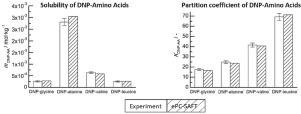当前位置:
X-MOL 学术
›
Fluid Phase Equilibr.
›
论文详情
Our official English website, www.x-mol.net, welcomes your
feedback! (Note: you will need to create a separate account there.)
Solubility of DNP-amino acids and their partitioning in biodegradable ATPS: experimental and ePC-SAFT modeling
Fluid Phase Equilibria ( IF 2.8 ) Pub Date : 2021-01-01 , DOI: 10.1016/j.fluid.2020.112830 Kamila Wysoczanska , Birte Nierhauve , Gabriele Sadowski , Eugénia A. Macedo , Christoph Held
Fluid Phase Equilibria ( IF 2.8 ) Pub Date : 2021-01-01 , DOI: 10.1016/j.fluid.2020.112830 Kamila Wysoczanska , Birte Nierhauve , Gabriele Sadowski , Eugénia A. Macedo , Christoph Held

|
Abstract Predicting the behavior of dinitrophenylated amino acids (DNP-AA) in aqueous solutions requires an understanding and accurate description of interactions that can occur in such systems. In this work, some properties of DNP-AA (DNP-glycine, DNP-alanine, DNP-valine, DNP-leucine) have been determined experimentally. These were liquid densities obtained at T=298.15 – 318.15 K, p=1 bar, and pH-dependent solubility data measured at T=298.15 K, p=1 bar. It was observed that the solubility order for DNP-AA does not follow the same sequence as for aliphatic amino acids. The thermodynamic model ePC-SAFT has been applied to predict the properties density and solubility, and additionally to estimate partition coefficients of DNP-AA in PEG (PEG 4000, PEG 6000, PEG 8000) - organic salt (sodium citrate, potassium citrate, potassium sodium tartrate) aqueous two-phase systems (ATPS). ePC-SAFT pure-component and binary interaction parameters for neutral DNP-AA were acquired using the joinzt joint-parameter method, namely by combining the parameters for dinitrobenzene with parameters for amino acids (glycine, L-alanine, L-valine, L-leucine) from literature. The pure-component parameters for charged DNP-AA- were inherited from their parent neutral DNP-AA. This work shows that ePC-SAFT allows predicting liquid densities and solubilities of neutral DNP-AA with good agreement to experimental results. Moreover, adjusting in sum six binary parameters between charged DNP-AA- and phase-forming species allowed modeling partition coefficients of four DNP-AA in nine different PEG – organic salt ATPS, each at four different ATPS compositions. This can be considered an excellent modeling result and proofs the suitability of ePC-SAFT for such systems.
中文翻译:

DNP-氨基酸的溶解度及其在可生物降解的 ATPS 中的分配:实验和 ePC-SAFT 建模
摘要 预测二硝基苯基化氨基酸 (DNP-AA) 在水溶液中的行为需要理解和准确描述此类系统中可能发生的相互作用。在这项工作中,已通过实验确定了 DNP-AA(DNP-甘氨酸、DNP-丙氨酸、DNP-缬氨酸、DNP-亮氨酸)的一些特性。这些是在 T=298.15 – 318.15 K,p=1 bar 时获得的液体密度,以及在 T=298.15 K,p=1 bar 时测得的 pH 依赖性溶解度数据。据观察,DNP-AA 的溶解度顺序与脂肪族氨基酸的顺序不同。热力学模型 ePC-SAFT 已用于预测性质密度和溶解度,此外还用于估计 DNP-AA 在 PEG(PEG 4000、PEG 6000、PEG 8000)-有机盐(柠檬酸钠、柠檬酸钾、酒石酸钾钠)水性两相系统(ATPS)。中性 DNP-AA 的 ePC-SAFT 纯组分和二元相互作用参数使用 joinzt 联合参数方法获得,即将二硝基苯的参数与氨基酸(甘氨酸、L-丙氨酸、L-缬氨酸、L-亮氨酸)来自文献。带电 DNP-AA- 的纯组分参数继承自其母中性 DNP-AA。这项工作表明,ePC-SAFT 可以预测中性 DNP-AA 的液体密度和溶解度,与实验结果非常吻合。此外,在带电的 DNP-AA- 和相形成物质之间总共调整六个二元参数允许对四种 DNP-AA 在九种不同的 PEG - 有机盐 ATPS 中的分配系数进行建模,每种都具有四种不同的 ATPS 组成。
更新日期:2021-01-01
中文翻译:

DNP-氨基酸的溶解度及其在可生物降解的 ATPS 中的分配:实验和 ePC-SAFT 建模
摘要 预测二硝基苯基化氨基酸 (DNP-AA) 在水溶液中的行为需要理解和准确描述此类系统中可能发生的相互作用。在这项工作中,已通过实验确定了 DNP-AA(DNP-甘氨酸、DNP-丙氨酸、DNP-缬氨酸、DNP-亮氨酸)的一些特性。这些是在 T=298.15 – 318.15 K,p=1 bar 时获得的液体密度,以及在 T=298.15 K,p=1 bar 时测得的 pH 依赖性溶解度数据。据观察,DNP-AA 的溶解度顺序与脂肪族氨基酸的顺序不同。热力学模型 ePC-SAFT 已用于预测性质密度和溶解度,此外还用于估计 DNP-AA 在 PEG(PEG 4000、PEG 6000、PEG 8000)-有机盐(柠檬酸钠、柠檬酸钾、酒石酸钾钠)水性两相系统(ATPS)。中性 DNP-AA 的 ePC-SAFT 纯组分和二元相互作用参数使用 joinzt 联合参数方法获得,即将二硝基苯的参数与氨基酸(甘氨酸、L-丙氨酸、L-缬氨酸、L-亮氨酸)来自文献。带电 DNP-AA- 的纯组分参数继承自其母中性 DNP-AA。这项工作表明,ePC-SAFT 可以预测中性 DNP-AA 的液体密度和溶解度,与实验结果非常吻合。此外,在带电的 DNP-AA- 和相形成物质之间总共调整六个二元参数允许对四种 DNP-AA 在九种不同的 PEG - 有机盐 ATPS 中的分配系数进行建模,每种都具有四种不同的 ATPS 组成。











































 京公网安备 11010802027423号
京公网安备 11010802027423号